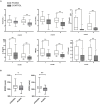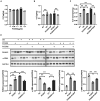PCSK9 inhibitors ameliorate arterial stiffness in ACS patients: evidences from Mendelian randomization, a retrospective study and basic experiments
- PMID: 38860206
- PMCID: PMC11163136
- DOI: 10.3389/fmed.2024.1408760
PCSK9 inhibitors ameliorate arterial stiffness in ACS patients: evidences from Mendelian randomization, a retrospective study and basic experiments
Abstract
Background: Current evidences suggest that Proprotein Convertase Subtilisin/kexin Type 9 inhibitors (PCSK9i) exhibit a protective influence on acute coronary syndrome (ACS). Nevertheless, further investigation is required to comprehend the impact and mechanisms of these pharmaceutical agents on inflammatory factors and arterial stiffness (AS) in patients with ACS. Consequently, the objective of this study is to ascertain the influence of PCSK9i on arterial stiffness in ACS patients and elucidate the underlying mechanisms behind their actions.
Methods: This study employed Mendelian randomization (MR) analysis to examine the association between genetic prediction of PCSK9 inhibition and arterial stiffness. Data of 71 patients with ACS were retrospectively collected, including PCSK9i group (n = 36, PCSK9 inhibitors combined with statins) and control group (n = 35, statins only). Blood lipid levels, inflammatory markers and pulse wave velocity (PWV) data were collected before treatment and at 1 and 6 months after treatment for analysis. Additionally, cell experiments were conducted to investigate the impact of PCSK9i on osteogenesis of vascular smooth muscle cells (VSMCs), utilizing western blot (WB), enzyme-linked immunosorbent assay (ELISA), and calcification index measurements.
Results: The results of the MR analysis suggest that genetic prediction of PCSK9 inhibition has potential to reduce the PWV. Following treatment of statins combined with PCSK9 inhibitors for 1 and 6 months, the PCSK9i group exhibited significantly lower levels of total cholesterol (TC), low-density lipoprotein cholesterol (LDL-C), C-reactive protein (CRP), interleukin-6 (IL-6), fibrinogen (FIB) and procalcitonin (PCT) compared to the control group (p < 0.05). Additionally, PWV in the PCSK9i group demonstrated significant reduction after 6 months of treatment and was found to be associated with the circulating CRP level. In cell experiments, PCSK9i pretreatment ameliorated osteogenesis of VSMCs through reducing the deposition of calcium ions, alkaline phosphatase (ALP) activity, and expression of runt-related transcription factor 2 (RUNX2).
Conclusion: PCSK9i have potential to enhance arterial stiffness in ACS patients. Specifically, at the clinical level, this impact may be attributed to alterations in circulating CRP levels. At the cellular level, it is associated with the signaling pathway linked to RUNX2.
Keywords: C-reactive protein; Mendelian randomization; PCSK9 inhibitors; acute coronary syndromes; arterial stiffness.
Copyright © 2024 Xu, Wang, Wang, Wang, Jiang, Du, Cheng, Zhang, Wang, Jiao, Xing, Ma and Li.
Conflict of interest statement
The authors declare that the research was conducted in the absence of any commercial or financial relationships that could be construed as a potential conflict of interest.
Figures






Similar articles
-
Effect of adding PCSK9 inhibitors to lipid-lowering interventions on arterial stiffness: A systematic review and meta-analysis.Eur J Clin Invest. 2024 Oct;54(10):e14269. doi: 10.1111/eci.14269. Epub 2024 Jun 21. Eur J Clin Invest. 2024. PMID: 39031778
-
Early Use of PCSK9 Inhibitors in the Prognosis of Patients with Acute Coronary Syndrome by Protecting Vascular Endothelial Function.Pharmacology. 2025;110(1):1-14. doi: 10.1159/000540083. Epub 2024 Jul 17. Pharmacology. 2025. PMID: 38964284 Clinical Trial.
-
Causal relationship between PCSK9 inhibitor and primary glomerular disease: a drug target Mendelian randomization study.Front Endocrinol (Lausanne). 2024 Mar 6;15:1335489. doi: 10.3389/fendo.2024.1335489. eCollection 2024. Front Endocrinol (Lausanne). 2024. PMID: 38510702 Free PMC article.
-
Chronic PCSK9 inhibitor therapy leads to sustained improvements in endothelial function, arterial stiffness, and microvascular function.Microvasc Res. 2023 Jul;148:104513. doi: 10.1016/j.mvr.2023.104513. Epub 2023 Mar 3. Microvasc Res. 2023. PMID: 36870561
-
Impact of early initiation of proprotein convertase subtilisin/kexin type 9 inhibitors in patients with acute coronary syndrome: A systematic review meta-analysis.Indian Heart J. 2023 Nov-Dec;75(6):416-422. doi: 10.1016/j.ihj.2023.09.005. Epub 2023 Sep 29. Indian Heart J. 2023. PMID: 37777180 Free PMC article.
References
-
- Kaasenbrood L, Boekholdt SM, van der Graaf Y, Ray KK, Peters RJG, Kastelein JJP, et al. . Distribution of estimated 10-year risk of recurrent vascular events and residual risk in a secondary prevention population. Circulation. (2016) 134:1419–29. doi: 10.1161/CIRCULATIONAHA.116.021314, PMID: - DOI - PubMed
LinkOut - more resources
Full Text Sources
Research Materials
Miscellaneous

